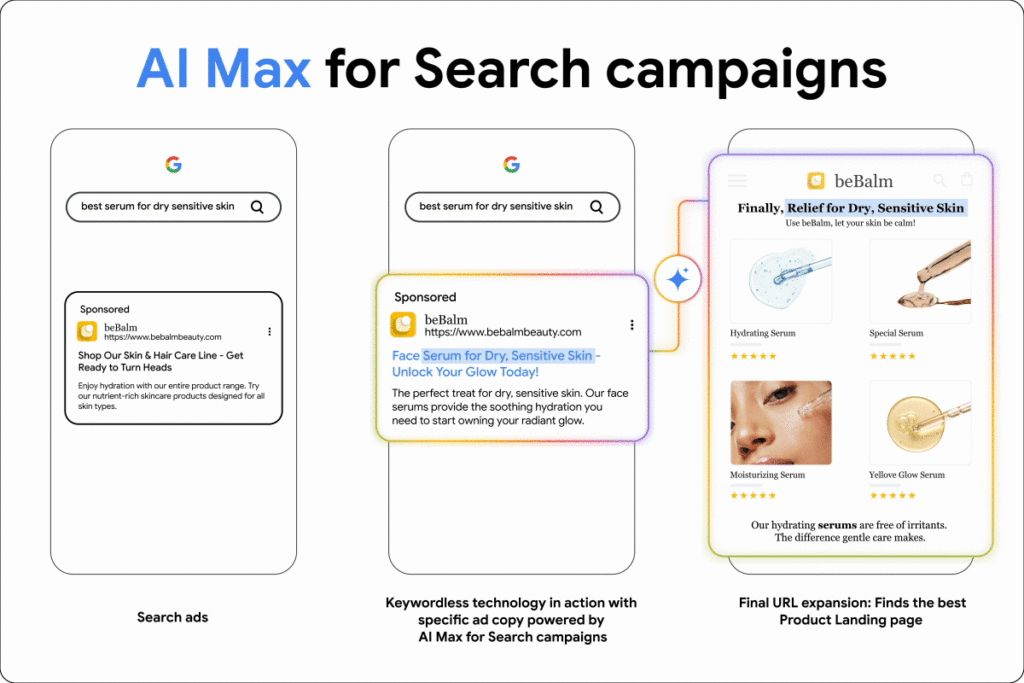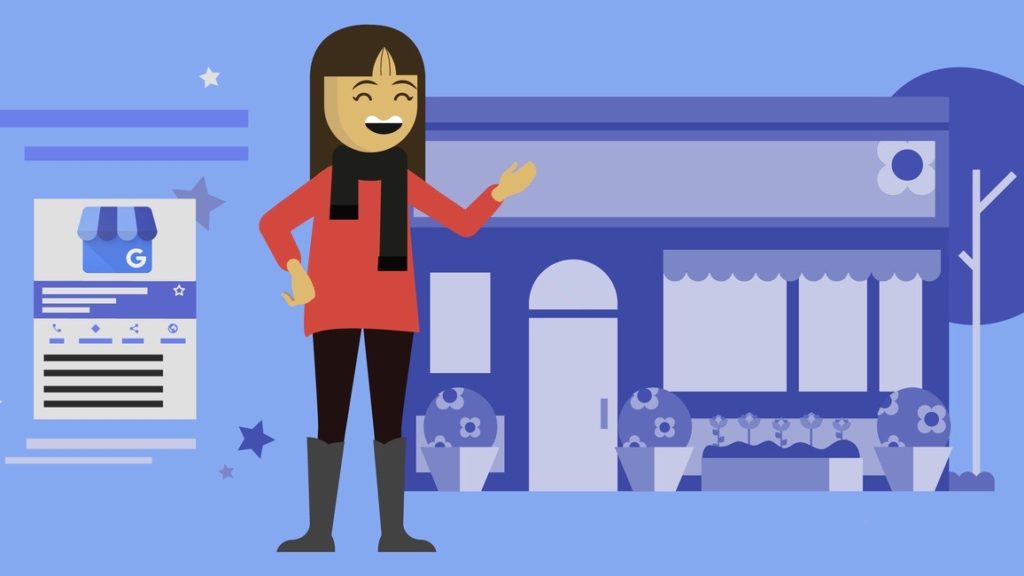
Key Points:
AI Max for Google Search Ads: A Technical Deep Dive
Are you considering AI Max for Search? Read this Technical Deep Dive by the Experts at OMDM
In the ever-evolving landscape of digital advertising, the only constant is change. Here at Overtop Media Digital Marketing in Charlotte, NC, we’ve seen platforms shift from manual bidding to sophisticated automation. The latest and most significant evolution in this trend is Google’s AI Max for Search. It’s more than just an update; it’s a fundamental rethinking of how search campaigns are managed and optimized.
For businesses looking to maintain a competitive edge, understanding this technology isn’t just beneficial—it’s critical. This article provides a technical, in-depth analysis of AI Max, moving beyond the surface-level claims to explore its core mechanics, real-world performance implications, and the strategic framework required to harness its power effectively.
Deconstructing AI Max: A Technical Breakdown
First, it’s crucial to understand that AI Max is not a new campaign type. It is an optional, AI-powered enhancement layer that can be activated on existing Search campaigns.1 This suite is built on two interdependent pillars: Search Term Matching for targeting and Asset Optimization for creative delivery.1 A non-negotiable prerequisite is the use of Smart Bidding strategies—specifically Maximize Conversions or Maximize Conversion Value—as these algorithms are essential for the Search Term Matching feature to function.5
The Core Engine: Search Term Matching
At the heart of AI Max is Search Term Matching (STM), a hybrid targeting technology that merges the reach of Broad Match with a “keywordless” dimension.1 Its mechanism is sophisticated: the AI analyzes a vast array of signals far beyond an advertiser’s keyword list. It learns from the content on your landing pages, the copy within your ad assets, and historical performance data to identify and target entirely new, relevant search queries.8
While it leverages broad match intelligence, STM is engineered to be more expansive and less predictable, functioning as an AI-driven, more aggressive evolution of the concept.11
The true paradigm shift is the “keywordless” component. This technology empowers Google’s AI to trigger ads for queries even when no semantically related keyword exists in the ad group.10 It achieves this by matching the inferred intent of a user’s search directly to the content of the advertiser’s website and ad assets. This signals a deliberate move away from simple keyword-to-query matching toward a more holistic model of intent targeting, designed to interpret a user’s entire conversational journey.8 This architecture is Google’s answer to the increasing complexity of user searches in an era of AI Overviews and conversational AI, positioning AI Max as a tool to maintain ad visibility on the SERP of the future.15
The Delivery System: Asset Optimization
Asset Optimization is the necessary counterpart to the broad net cast by STM. It consists of two primary functions:
- Text Customization: Formerly known as Automatically Created Assets (ACA), this feature uses generative AI to dynamically craft new headlines and descriptions in real-time.1 Based on the user’s query, the selected landing page, and existing ad copy, its goal is to maximize Ad Strength and relevance across the thousands of new queries uncovered by STM.5
- Final URL Expansion: Operating similarly to Dynamic Search Ads (DSAs), this function gives the AI autonomy to override the advertiser-specified final URL.1 If the system predicts a different landing page on the domain will yield a higher conversion probability for a given search, it will direct the user there, aiming to create a more seamless journey from intent to conversion.2
These pillars are functionally interdependent. The vast reach expansion from STM creates an urgent need for the automated, real-time creative adaptation provided by Asset Optimization. Without it, ads would suffer from low relevance and wasted spend.
The Performance Paradox: Google’s Promises vs. In-Market Realities
Evaluating AI Max reveals a stark contrast between Google’s official data and the varied, often critical, results reported by independent practitioners. This suggests its impact is highly contingent on industry, account structure, and strategic objectives.
Google’s Official Claims
Google’s marketing is built on compelling top-line metrics. The company claims advertisers who activate AI Max typically see 14% more conversions or conversion value at a similar CPA or ROAS.3 For campaigns historically reliant on the tight control of exact and phrase match, Google projects an even greater uplift of 27%.7
Case studies support this narrative:
- L’Oréal Chile reportedly doubled its conversion rate while reducing its cost-per-conversion by 31% by unlocking new, high-intent queries.2
- MyConnect, an Australian utility service, saw a 16% increase in leads at a 13% lower CPA, with 30% of conversions coming from newly discovered queries.2
- Volvo was highlighted for using AI Max to interpret complex, conversational queries like “electric SUV for large family” and serving a perfectly tailored, dynamically generated ad in response.14

Independent Analysis: A More Nuanced Reality
Independent analysis paints a more complex picture. Early tests reveal a spectrum of outcomes, demonstrating that success is far from guaranteed and is heavily influenced by the business vertical.21
| Industry | Match Type | Avg. CPC (€) | Conversion Rate (CVR) (%) | Analysis |
| Fashion E-commerce | AI Max | €0.08 | 2.15% | Strong performance. Achieved the lowest CPC and a competitive CVR, outperforming broad match. Discovered 81.3% new queries, proving valuable for reach expansion. |
| Broad Match | €0.12 | 2.89% | Outperformed by AI Max on cost, but slightly higher CVR. | |
| Exact Match | €0.67 | 8.45% | Highest CVR but at a significantly higher cost. | |
| B2B SaaS | AI Max | €0.89 | 0.76% | Poor performance. Worst-performing match type. Captured too many low-intent, informational queries, leading to a high CPA. Outperformed even by broad match. |
| Broad Match | €0.72 | 1.23% | Better CVR than AI Max at a lower CPC. | |
| Exact Match | €1.84 | 4.67% | Highest CVR, indicating the importance of precision in this vertical. | |
| Tourism & Travel | AI Max | €0.11 | 1.47% | Neutral performance. Contribution was minor. Discovered 77.5% new queries but had the lowest CVR of all expansion-oriented match types. |
| Broad Match | €0.09 | 3.79% | Significantly better CVR than AI Max at a lower cost. | |
| Phrase Match | €0.16 | 6.25% | Strong performance, highlighting the value of controlled expansion. |
Data synthesized from early case study analysis.21
This data clearly shows inconsistent performance. While AI Max succeeded in the fast-moving environment of fashion e-commerce, it failed in the complex B2B sales cycle that requires high-intent, qualified leads.
Practitioner Feedback: The Unfiltered View
Feedback from professional forums is largely critical, with common descriptions including “absolute trash,” “horrible,” and a “budget-burning” feature that is “not ready yet”.22 The most pervasive complaint is the quality of traffic, with consistent reports of irrelevant, low-intent queries that do not convert, such as matching “massage” to “chiropractor near me” or “TV repair” for a “TV installer” client.22
This discrepancy highlights a fundamental difference in how “success” is defined. Google’s model prioritizes reach expansion and conversion volume. In contrast, expert advertisers prioritize conversion quality, ROAS efficiency, and alignment with business goals.
The Advertiser’s Dilemma: Ceding Control for Automated Scale
Adopting AI Max forces a strategic trade-off between the precision of manual control and the potential scale of AI-driven automation. It requires ceding granular control over keywords, ad copy, and landing pages in exchange for discovering untapped audiences.7
| Feature | Traditional Search (Advertiser Control) | AI Max for Search (AI Control) |
| Keyword Targeting | Advertiser defines precise keyword lists and match types. | Google’s AI targets additional searches beyond provided keywords based on its analysis of assets and user intent. |
| Ad Copy & Creatives | Advertiser writes and assigns specific ad copy for each ad group. | AI dynamically customizes headlines and descriptions. Advertiser can only remove unwanted assets after generation. |
| Landing Page Selection | Advertiser selects a specific, static landing page URL for each ad. | AI can override the specified URL and send users to any page on the domain it deems more relevant. |
| Bidding & Budget | Advertiser can set manual bids or use Smart Bidding with granular controls. | Requires Smart Bidding. Keywordless expansion can lead to less predictable spend allocation. |
Data synthesized from industry analysis.7
This exchange introduces significant, documented risks:
- Brand Safety and Messaging Control: AI-generated ad copy can be off-brand, inaccurate, or legally problematic.19
- Budget Control and Spend Leakage: Advertisers report rapid, uncontrolled budget consumption and, in some cases, budgets leaking from Search into the Display Network.7
- Irrelevant Traffic and Lead Quality Dilution: The most common risk is a degradation of traffic quality, which is especially detrimental for lead generation campaigns.7
- Cannibalization of Existing Campaigns: AI Max may capture traffic that would have been reached by existing, well-optimized campaigns, making it difficult to ascertain its true incremental value.17
Success with AI Max is not merely a platform setting; it presupposes a high-quality, well-organized website and a strong creative foundation from which the AI can learn effectively—a “garbage in, garbage out” scenario.19
Mastering the Machine: A Guide to AI Max Governance
While AI Max is highly automated, Google provides a suite of controls that allow savvy advertisers to impose strategic guardrails. The effectiveness of the feature is often determined by the skill of the manager in deploying these governance tools.
The First Line of Defense: Proactive Exclusions
- Negative Keywords: With expanded reach, diligent negative keyword management is more critical than ever. A comprehensive list, including competitor brand terms, should be implemented from day one.19
- URL Exclusions: To prevent Final URL Expansion from sending traffic to non-converting pages (e.g., “About Us,” careers, blogs), use URL exclusions at the campaign level.24
- Brand Exclusions: Use the “Brand settings” feature to create exclusion lists to prevent ads from appearing alongside specific competitors or inclusion lists to prioritize your own brand terms.1
Granular, In-Campaign Controls
- Search Term Matching Toggle: This can be disabled at the ad group level, allowing for a hybrid campaign where some ad groups are tightly controlled while others are used for AI-powered expansion.10
- Asset Optimization Toggles: Both Text Customization and Final URL Expansion can be individually disabled at the campaign level, providing an opt-out for regulated industries or those with strict brand guidelines.1
- Locations of Interest: This ad group-level feature allows targeting based on a user’s geographic intent rather than just their physical location, capturing high-intent customers early in their planning process.1
Future Controls
Google is developing a “text guidelines” feature to allow advertisers to provide specific instructions to the AI, ensuring generated copy remains brand-safe and compliant.24
Enhanced Transparency: New Reporting & Measurement Capabilities
Addressing the “black box” criticism of past automation, AI Max includes an enhanced reporting suite to provide greater transparency into the AI’s actions.17
New Reporting Metrics and Views
- Search Terms Report Enhancements:
- “AI Max” Match Type: Terms generated by the feature are labeled with a distinct “AI Max” match type for easy segmentation and analysis.1
- “Source” Column: This specifies whether a match originated from a broad match expansion or the “keywordless” technology.1
- Combined Journey View: A new view consolidates the matched search term, the dynamically generated headline, and the final URL, providing an end-to-end picture of the customer journey.1
- New Keyword-Level Metrics: At the aggregate level, two new metrics quantify AI Max’s impact 28:
- AI Max expanded matches: Traffic from AI-created broad-match keywords.
- AI Max expanded landing pages: Traffic from queries triggered by keywordless analysis of landing pages and assets.
These new reports are actionable tools for a continuous optimization loop: harvesting high-performing terms to add as keywords and negating irrelevant queries to train the AI over time.
Overtop Media’s Strategic Framework for AI Max Adoption
The decision to implement AI Max should be a calculated choice. Here is our framework for testing and adoption.
Identifying the Right Scenarios
Prime Candidates for Testing AI Max 7:
- Mature Accounts at Scale: Campaigns that have already maximized impression share and are seeking new avenues for growth.
- Exact/Phrase Match-Heavy Accounts: These accounts stand to see the largest gains in conversion volume.
- Businesses with High-Quality Websites: A content-rich, well-structured site provides the high-quality signals the AI needs.
- E-commerce: AI Max excels at matching long-tail product searches to specific product detail pages.
When to Proceed with Caution 7:
- Lead Generation (Especially B2B): The risk of generating low-quality leads is acute. Rigorous lead qualification and aggressive negative keyword management are required.
- Accounts with Tight Budgets: The initial learning period can lead to unpredictable and inefficient spend.
- Industries with Strict Compliance: The risk from AI-generated ad copy is higher. Text Customization may need to be disabled.
The Blueprint for a Controlled Experiment
A methodical approach is essential to measure impact and mitigate risk.
- Utilize Google’s Built-in Experiments: Use the “Experiments” feature for a clean 50/50 traffic split within a single campaign, which avoids the data errors of a manual A/B test.25
- Experimental Setup Best Practices4:
- Isolate for Incremental Growth: For the most rigorous test, create a separate campaign for the AI Max experiment. Use negative keywords to block all of your primary brand and core keywords from your standard campaigns. This forces the AI Max campaign to find truly new, incremental traffic rather than cannibalizing existing efforts.30
- Set a Controlled Budget: Start with a modest, defined budget (Google suggests avoiding tests on campaigns under $50/day).4
- Account for the Learning Period: Run the experiment for at least four weeks, but exclude the first one to two weeks from your final performance analysis to account for the AI’s initial learning phase.4
- Engage in Hyper-Vigilant Monitoring: During the test, monitor the search terms report at least twice as often as a standard campaign to aggressively add negative keywords and guide the AI’s learning.13
Final Verdict: A Copilot, Not the Pilot
AI Max for Search is not a simple “on” switch for guaranteed performance. It is a powerful, high-risk, high-reward tool engineered for reach expansion. Its success requires significant strategic oversight, diligent management of its controls, and a clear understanding of its risks.
The most accurate analogy is that of a “copilot, not the pilot”.19 The AI can serve as a powerful assistant, accelerating processes and discovering new opportunities at a speed no human can match. However, the human strategist must remain firmly in control. It is the advertiser’s responsibility to set the destination (goals), program the flight plan (guardrails and exclusions), monitor the instruments (reporting data), and be ready to take manual control to correct the course.
At Overtop Media Digital Marketing, we believe success with AI Max will be found not in blind trust in automation, but in a sophisticated, symbiotic partnership between human expertise and machine learning. If you’re looking to navigate this new frontier of search advertising, our team in Charlotte is here to help you chart the course.









